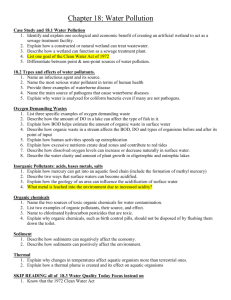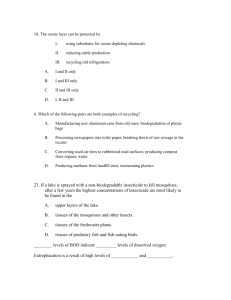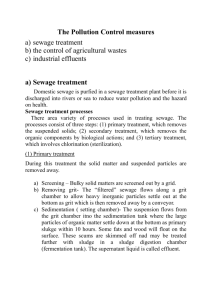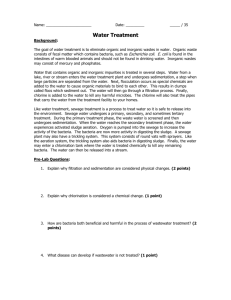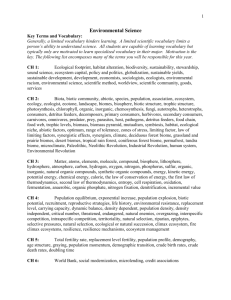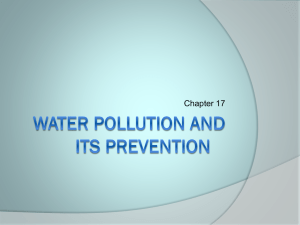water technology
advertisement
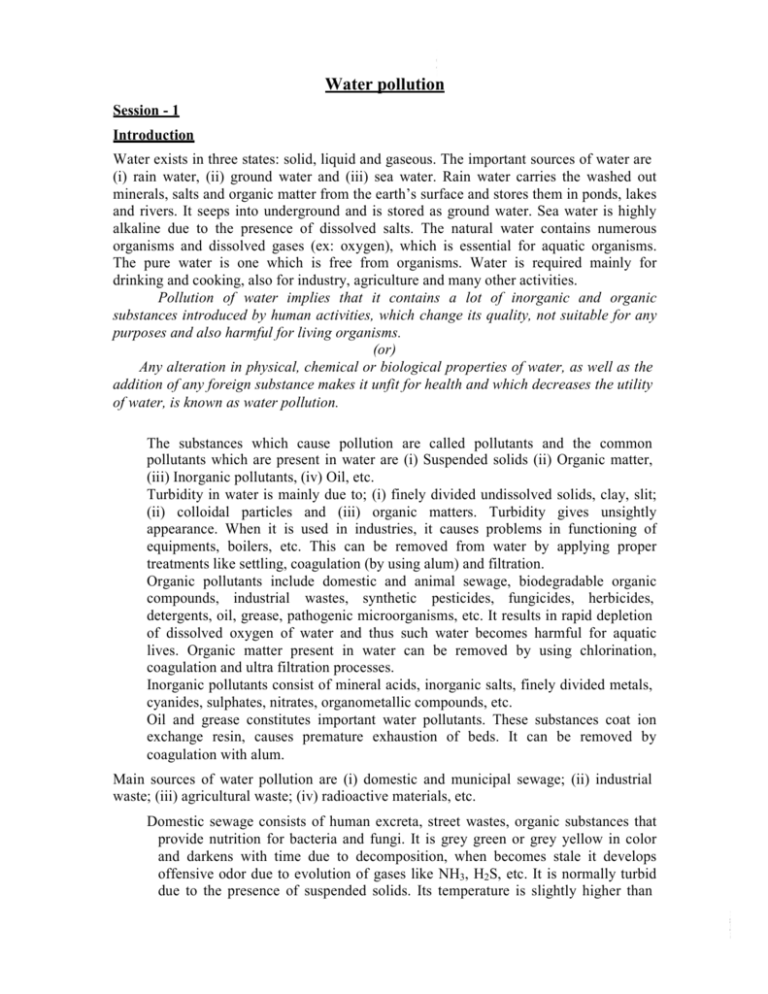
Water pollution Session - 1 Introduction Water exists in three states: solid, liquid and gaseous. The important sources of water are (i) rain water, (ii) ground water and (iii) sea water. Rain water carries the washed out minerals, salts and organic matter from the earth’s surface and stores them in ponds, lakes and rivers. It seeps into underground and is stored as ground water. Sea water is highly alkaline due to the presence of dissolved salts. The natural water contains numerous organisms and dissolved gases (ex: oxygen), which is essential for aquatic organisms. The pure water is one which is free from organisms. Water is required mainly for drinking and cooking, also for industry, agriculture and many other activities. Pollution of water implies that it contains a lot of inorganic and organic substances introduced by human activities, which change its quality, not suitable for any purposes and also harmful for living organisms. (or) Any alteration in physical, chemical or biological properties of water, as well as the addition of any foreign substance makes it unfit for health and which decreases the utility of water, is known as water pollution. The substances which cause pollution are called pollutants and the common pollutants which are present in water are (i) Suspended solids (ii) Organic matter, (iii) Inorganic pollutants, (iv) Oil, etc. Turbidity in water is mainly due to; (i) finely divided undissolved solids, clay, slit; (ii) colloidal particles and (iii) organic matters. Turbidity gives unsightly appearance. When it is used in industries, it causes problems in functioning of equipments, boilers, etc. This can be removed from water by applying proper treatments like settling, coagulation (by using alum) and filtration. Organic pollutants include domestic and animal sewage, biodegradable organic compounds, industrial wastes, synthetic pesticides, fungicides, herbicides, detergents, oil, grease, pathogenic microorganisms, etc. It results in rapid depletion of dissolved oxygen of water and thus such water becomes harmful for aquatic lives. Organic matter present in water can be removed by using chlorination, coagulation and ultra filtration processes. Inorganic pollutants consist of mineral acids, inorganic salts, finely divided metals, cyanides, sulphates, nitrates, organometallic compounds, etc. Oil and grease constitutes important water pollutants. These substances coat ion exchange resin, causes premature exhaustion of beds. It can be removed by coagulation with alum. Main sources of water pollution are (i) domestic and municipal sewage; (ii) industrial waste; (iii) agricultural waste; (iv) radioactive materials, etc. Domestic sewage consists of human excreta, street wastes, organic substances that provide nutrition for bacteria and fungi. It is grey green or grey yellow in color and darkens with time due to decomposition, when becomes stale it develops offensive odor due to evolution of gases like NH3, H2S, etc. It is normally turbid due to the presence of suspended solids. Its temperature is slightly higher than ordinary water. These pollutants cause many hazardous effects on health. Discharge of sewage in river and lakes spreads water borne diseases. A pollutant present in industrial waste water damages biological activities and kills many useful organisms. Most of the industrial wastes dissolved in water are particulate in nature and are present at the bottom of the water system. These acts as poison for the aquatic organisms. Further, toxic metals present in industrial effluents are extremely hazardous for living beings. Agricultural discharge consists of pesticides, fertilizers, insecticides, etc. In agriculture in order to increase the production and to escape the crops from various diseases, the fertilizers and insecticides are used. Any substance or a mixture of substances which prevents, repels, destroys any pest is called a pesticide. These pollutants contaminate the water and when this is used by human being, affect the oxygen carrying capacity of hemoglobin and consequently causes suffocation and irritation to respiratory and vascular system. Radioactive wastes are mainly from atomic explosion and processing of radioactive materials near the source of water. The other sources are waste from hospitals, research laboratories, etc. The radioactive pollutants in water cause serious skin cancer, carcinoma, leukemia, DNA breakage, etc. Water pollution by heavy metals: About 70 metallic elements are called heavy metals, as they have atomic numbers of 22 to 92 and atomic weight higher than that of sodium and with a specific gravity of more than 5.0. Only a few of these heavy metals are considered potentially damaging to living systems. Session - 2 Sources and ill effects of heavy metals and inorganic species Heavy Metal Cd Hg Pb CN- Sources Their effects Discharges from electroplating Gets adsorbed on suspended matter in industries, Battery manufacturing the water, when it is consumed causes units, metallurgical industries, etc. liver and kidney necrosis, increased salivation nausea, acute gastritis, etc. Effluents from chloro-alkali Mercury poisoning causes kidney industries, pesticide industries, damage, and exhibits the symptoms like Chemical industries, etc. numbness in the limbs, muscles, blurred vision leading to blindness, emotional disturbances etc. It also damages brain and nervous system, and paralysis followed by death. Electric storage battery industries, A cumulative poison causing loss of petroleum industries, ceramic apatite, constipation, abdominal pain, industries, electric cable insulation, mental retardation, nervous disorder and paint industries, plastic industries, brain damage. pesticides, pipe-manufacturing units, etc. Metal finishing and cleaning, Cyanide is extremely toxic. Exposure NH3 H2S electroplating, coke ovens and many other industrial processes generate cyanide and discharge as effluent to water bodies. Ammonia is generated by the biological decay, reduction of nitrates under anaerobic conditions. By bacterial reduction of sulphate and decomposition of organic matter. even to small quantities over longer periods causes loss of apatite, dizziness, etc. In high concentration, it is toxic to fish and other aquatic organisms. It imparts characteristic odor to water. Causes corrosion, imparts bad odor. Sewage treatment The polluted water is characterized by its oxygen demand and solid content. The biological oxygen demand (BOD) measures the level of organic pollution in the sewage water. The sewage must be treated before being discharged into the water bodies. The treatment is carried out in three stages- primary, secondary and tertiary. (i) In primary treatment, the suspended solids and floating objects are removed using coarse screens and sieves. (ii)In secondary treatment, the maximum proportions of the suspended inorganic/ organic solids are removed from the liquid sewage. The liquid material passes into the sedimentation tank and finely suspended particles are allowed to settle by adding coagulants like Alum. The suspended materials settle down in the tanks and forms sludge. The sewage water after sedimentation process is allowed for aerobic oxidation. The organic matter is converted into CO2, the nitrogen into NH3 and nitrites to nitrates. The treatment is carried out by activated sludge process. The above process is based on the principle that if an adequate amount of oxygen / air is passed through the sewage containing aerobes, complete aerobic oxidation occurs. This oxidation process becomes speedy by the addition of a part of sludge from the previous process, called activated sludge. Settled sludge is sent back for feeding fresh bulk of sewage, while the remainder is disposed off by land spreading, sea burial etc. Tertiary treatment is applied to remove detergents, metal ions, nitrates and (iii)pesticides, as these are not removed in the earlier treatments. The phosphates are removed as calcium phosphates by adding calcium hydroxide at pH 10-11. At this pH, ammonium salts are also converted into ammonia. Fine particles are further removed by sedimentation in the presence of coagulants. The effluent is chlorinated to remove pathogenic bacteria’s and finally passed through activated charcoal to absorb gases. The treated water is of high clarity, free from odor and low BOD, therefore it is nearly equivalent to drinking water. Session -3 BIOLOGICAL OXYGEN DEMAND It is defined as the amount of oxygen required for the biological oxidation of the organic matter under aerobic conditions at 20oC and for a period of 5 days. Characteristics of BOD It is expressed in parts per million (ppm) or mg/dm3. Larger the concentration of decomposable organic matter, greater is the BOD and consequently more is the nuisance value. Strictly aerobic conditions are required. Determination is slow and time consuming. Determination BOD The method is based on the determination of dissolved oxygen before and after 5 days period, at 20oC. A known volume of sample of sewage is diluted with known volume of water containing nutrients for bacterial growth, whose dissolved oxygen content is predetermined. o The whole solution is incubated in a closed bottle at 20 C for 5 days. After incubation the unused oxygen is determined. The difference between the original value of oxygen content in the diluted water and unused oxygen of solution after 5 days gives BOD. CHEMICAL OXYGEN DEMAND (COD) COD is a measure of oxidisable sewage. It includes both the biologically oxidisable and biologically inert matter such as cellulose, as a result of which the value of COD is more than BOD. COD is defined as the amount of oxygen (in ppm) consumed under specified conditions, while oxidizing total organic load of the sample with a strong oxidizing agent (Ex: potassium dichromate) in the acid medium. Determination COD A definite volume of waste water sample (‘x’ ml) is refluxed with a known volume of K2Cr2O7 in H2 SO4 medium in the presence of AgSO4 (which acts as a catalyst) and HgSO4 (which eliminates interference due to chlorine). K2Cr2O7 oxidises all organic matter into water, CO2 and ammonia. The unreacted dichromate is titrated with a standard solution of ferrous ammonium sulphate (FAS) (Let the volume consumed is v2 ml). (v v 2 ) N FAS 8 1000 ; v 1 corresponds to the volume of FAS consumed COD = 1 x in the blank titration (i.e., in the absence of waste water sample). REFERENCE Environmental pollution by M.C. Dash. Problems 1. Calculate the COD of the effluent sample when 25 ml of an effluent requires 8.3 ml of 0.001M K2Cr2O7 for oxidation. [Given molecular mass of K2Cr2O7 =294). Solution: Given Concentration of K2Cr2O7 =0.001M Molecular mass of K2Cr2O7 =294 Volume of the effluent sample =25 ml Volume of the K2Cr2O7 consumed by the effluent =8.3ml (i) 1000ml of 1M K2Cr2O7 =294 g 8.3 ml of 0.001M K2Cr2O7 = (294×8.3×0.001)/1000 Amount of K2Cr2O7 present =2.4402mg (ii) 1mol of K2Cr2O7 6 equivalents of oxygen i.e., 294 mg of K2Cr2O7 6×8 mg of oxygen 6 8 2.4402 =0.3984 mg 2.4402 mg of K2Cr2O7 294 COD in 25 ml of water =0.3984 mg 1000ml of water =398.4/25=15.92 mg COD of water=15.92 mg/dm3 (iii) 2. What would be BOD value for a sample containing 200mg/dm3 of glucose assuming that it was completely oxidized in the BOD test? (Atomic wt. of C=12; H=1; O=16). C6H12O6+6O2 6CO2 +6H2O Molecular mass of glucose = 180 g From the above equation, 180g of glucose requires 192 g of oxygen 192 200 200 mg of glucose =213.33 mg 180 -----------xxx----------
